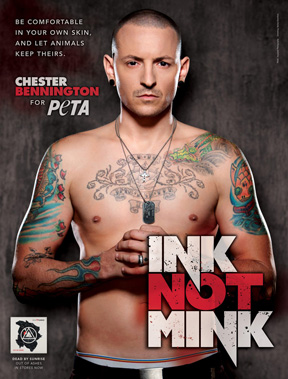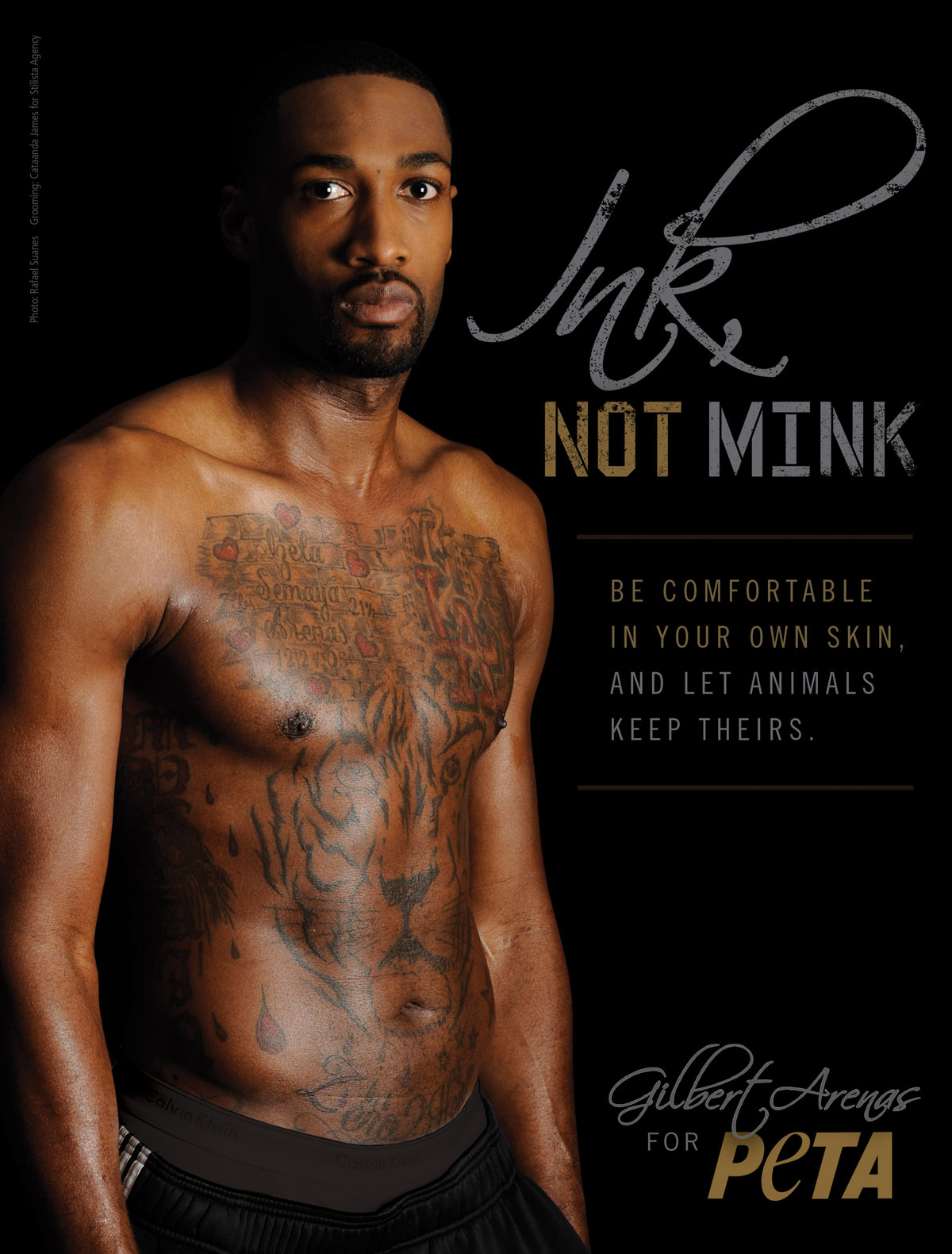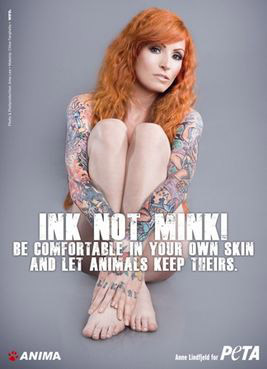Ink, Not Mink Campaign
While the "I'd rather go naked that wear fur"
campaign primarily displays women's bodies, the "Ink, not Mink"
campaign focuses more on men and often, a racialized male body. Their
slogan for this campaign is "be comfortable in your own skin and let
animals keep theirs." Although there are many flaws in this
comparison and one could argue that you don't have to be comfortable
in your own skin to let animals keep theirs or go naked to avoid
wearing fur, I will instead focus on the implications of the images
and the bodies represented in them. This campaign, with its male
subjects, reaffirms dominant ideologies that are just as flawed as
their slogan.
| The first ad from this campaign that
I will discuss features New York Nick's basketball player, Amar'e
Stoudemire shirtless, holding a basketball, and baring his tattooos.
Significantly, Amar'e is not completely naked as he is wearing shorts.
Because of this, his body is less on display than Karina Smirnoff's on
the previous page. Her body is on display in a sexualized manner but
Amar'e's is shown to display his tattoos and this is why we only see
his upper body. Thus the tattoos are the object and he himself is not
objectified as women are in other PETA ads. He is also looking
straight at the viewer in a way that asserts his power. According to
Jewitt and Oyama, his position as an athlete, which is clearly encoded
to the audience through the basketball in his hand, depicts another
kind of power, heterosexual power. Their research found that "sports
equipment and settings were used to signal competiveness between men
and as signifiers of their heterosexuality" (144). So Amar'e is both
being put on display as well as privileged in comparison to the not
shown referent of those who are not masculine and heterosexual. |
 |
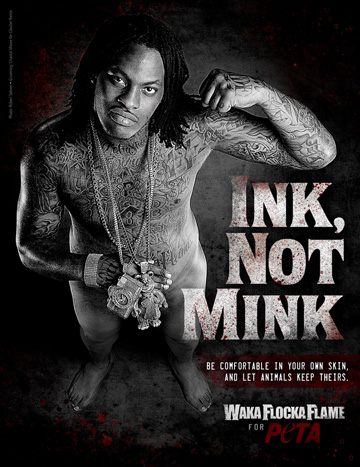 |
The second ad in this campaign features the rapper Waka Flocka
Flame completely naked. To illustrate his persona as a rapper, he is
pictured with large "bling" jewelry that acts as a phallic symbol by
covering the actual genitals. The point of view of the ad is slightly
above his eye level but the fact that he is looking up at the viewer
and making contact while also raising his arm in a way that could be
interpreted as either flexing his muscles or making a threatening fist
is his way of asserting his power. Because of this power, he is naked
but not objectified in the traditional feminized sense. The
positioning of his arm and fist can be anchored by the large, bold
"ink not mink" caption. This can draw a viewer to focus one of the
polysemic readings of the ad that Waka Flocka Flame is taking a stand
against fur and threatening opponents of his view.
Although these two ads mark a trend away from the traditional nude
female ads, some of the underlying ideologies about race that I see
expressed in the campaign are bothersome. PETA only features
celebrities in their notorious nude or close to nude-ads and in PETA's
history, they have been primarily white and female. The "ink not mink"
ads are breaking trend by using primarily African American male
celebrities to spread their message. However, the only African
American men in this campaign are rappers or professional athletes.
This reinforces cultural misconceptions that these are the paths that
African American men can become famous. PETA doesn't challenge this
assumption by featuring an African American actor, jazz singer, etc.
|
| Also, if we look at PETA ads of African American men
intertextually outside of the "Ink not Mink" campaign we see an even
more problematic representation. Particularly, we need to consider
these ads within the context of the ad on the right of an
African American as a caged animal sticking his face out to bite an
onlooker. Many of us know of, although it would appear PETA does not,
the lengthy history is which those in power in the Western world have
oppressed and "othered" those with less power, often being people of
African descent. The Image to the right of the man in the
cage characterized as an animal continues the painful history of
displaying and of often caging people of African descent that Coco
Fusco outlines. This history ranges from Columbus' capture of Native
peoples in 1493 to 19th century when "The Hottentot Venus" was
displayed for her body and had her genitals preserved at her death to
as late as 1992 when "a black woman midget is exhibited at the
Minnesota State Fair, billed as 'Tiny Teesha, the Island Princess'"
and arguably on to today (Fusco 41-43). The comparison of an African
American to a caged animal is ironic given the vegetarian ecofeminism
case for animal rights activism. Greta Gaard argues that this group
based their movement on "the conceptual linkages among sexism, racism,
and speciesism; on the recognition of flesh-eating as a form of
patriarchal domination; and on the basis of the culturally constructed
associations among women, animals, people of color, and nature" (127).
Given these conflicting views and actualizations, where does PETA
stand in regards to a progressive message? | 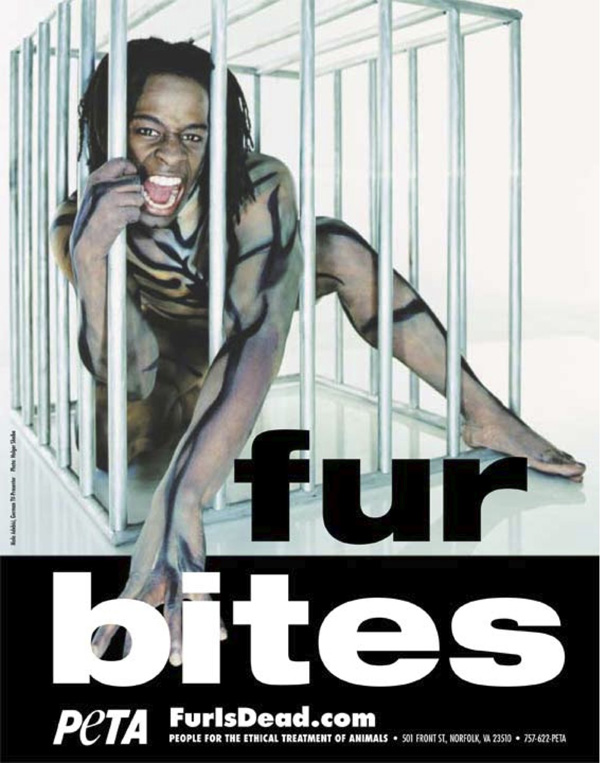 |
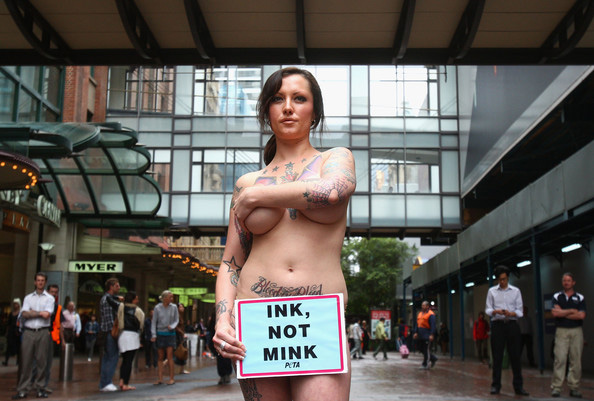 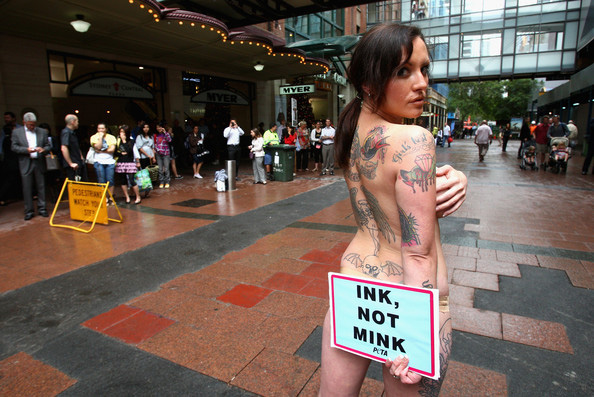 | The "Ink, Not Mink" slogan was also used in a
2009 protest in Sydney, Australia where tattooed model, Dani Lugosi,
stood in a street mall wearing nothing but a nude colored thong and
nipple pasties and holding an "Ink, Not Mink" sign. I argue that Dani
Lugosi is not objectified because she is actively engaging with
observers, even posing for a picture with one. The construction of
this protest in the physical space rather than as a print ad creates a
different dynamic for the presentation of a nude woman. First, she is
constructing her own performance. There isn't a group of people
coaching her on how to stand, what facial expressions to make, and
what angle to turn to hide her breasts like there would be at a photo
shoot for a PETA ad. She has agency over her body and she changes
stances, directions, and the positioning of her sign as she chooses.
She also isn't airbrushed like she would be in photographs in an ad
and although she is still on the thin side, she has a more realistic
looking body than Karina Smirnoff, Janice Dickinson, Pamela Anderson,
or the other celebrity PETA models. Since Dani is in the same
physical as space as her spectators, the effect of the male gaze is
lessened. If the male gaze is seated in voyerism, which distances and
objectifies the object, a human object/subject cannot be distanced in
the way that a print advertisement can (Rose 117). In this sense
models/protesters are play a more progressive subject rather than
their print advertisement counterparts that are more
objectified. |
Works Cited Fusco, Coco. "The
Other History of Intercultural Performance." English is Broken Here:
Notes on Cultural Fusion in the Americas. New York: The New Press,
1995. 37-64.
Gaard, Greta. "Vegetarian Ecofeminism: A Review Essay." Frontiers: A
Journal of Women Studies 23.3 (2002): 117-46. Print.
Jewitt, Carey and Rumiko Oyama, "Visual Meaning: a Social Semioric
Approach," in Theo van Leeuwen & Carey Jewitt (eds.), Handbook of
Visual Analysis (London: Sage, 2001), pp. 134-156.
Rose, Gillian. Visual Methodologies: An Introduction to the
Interpretation of Visual Materials. 2nd ed. London: SAGE Publications,
2007. Print.

